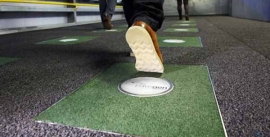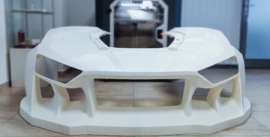 جدید
جدیدساخت عضله مصنوعی سیلیکونی نرم و سه برابر قویتر از عضلات طبیعی! (self-contained soft actuator three times stronger than natural muscle)
ساخت عضله مصنوعی سیلیکونی نرم و سه برابر قویتر از عضلات طبیعی!
self-contained soft actuator three times stronger than natural muscle
without the need of externals
گامی دیگر در جهت ساخت رباتهای انساننما!
با تلاش مهندسان برای توسعه یک عضله مصنوعی که میتواند هزار برابر وزن خود را تحمل کند، تولید رباتهای شبه انسان یک گام به واقعیت نزدیکتر میشود.
——————————————————–
ترجمه از گروه ترجمه ایران مواد
حرفه ای ترین تیم ترجمه مهندسی مواد کشور
———————————————————
محققان موفق به توسعه یک عضله نرم مصنوعی قابل چاپ سهبعدی شدند که برخلاف نمونههای قبلی به کمپرسور خارجی یا تجهیزاتی با ولتاژ بالا نیاز ندارد.
این عضله مصنوعی میتواند فشرده شده، کشیده شده، خم شده، پیچانده شده و همچنین میزان مختلفی از وزن را تحمل کند. یک تیم از مهندسان در دانشگاه کلمبیا میگویند تاکنون هیچ مادهای عملکردی شبیه به این عضله نداشته است.
پروفسور هود لیپسون اظهار کرد: این عضله که با الهام از موجودات زنده توسعه یافته میتواند در زمینههایی مانند تولید و مراقبتهای بهداشتی که در آنجا رباتها باید با انسان تماس و ارتباط برقرار کنند، مناسب باشد. وی افزود: بر خلاف دیگر رباتها، رباتهای نرم میتوانند حرکات طبیعی را تکرار کرده و وظایف مختلفی را به عهده بگیرند.
پروفسور لیپسون در ادامه افزود: “ما گامهای بزرگی در راستای توسعه ذهن رباتها برداشتهایم، اما بدن رباتها هنوز هم در مراحل ابتدایی قرار دارد. این کار یک قطعه بزرگ از یک پازل بوده و مانند زیستشناسی، یک محرک جدید می تواند هزاران راه مختلف را بوجود آورد.
محققان برای تولید این عضله مصنوعی از یک ماتریس لاستیک سیلیکون و اتانولی که در داخل میکرو حبابها توزیع شده بود، استفاده کردند. روش ساخت این عضلات استفاده از فرآیند پرینتر سه بعدی میباشد. این مواد سازگار با محیط زیست بوده و ساخت آن آسان و کم هزینه است.
پس از چاپ سهبعدی این مواد به شکل دلخواه و مورد نظر، این عضله مصنوعی با استفاده از یک سیم مقاومتی نازک که در داخل عضله جاسازه شده است و هشت ولت نیرو به صورت الکتریکی فعال میشود.
این عضله در طیف وسیعی از کاربردهای رباتیک آزمایش شد و در آن توانایی انقباض قابلتوجهی را از خود نشان داد. به گفته محققین این پژوهش، با استفاده از این عضله مصنوعی میتوان به ساخت رباتهای انسان نمایی که شباهتهای زیادی از نظر انعطاف پذیری با انسان دارند، نزدیک شد.
تصویر این عضلهی مصنوعی در اسکلت انشان که دست اسکلت را به اندازهی ۹۰ درجه بالا آورده است.
محققین به توسعه و ساخت بیشتر این عضلات ادامه خواهند داد و به دنبال استفاده از مواد هادی به جای سیم جاسازی شده در عضله هستند که منجر به افزایش سرعت پاسخ عضله و طول عمر آن خواهد شد. به کارگیری از هوش مصنوعی برای کنترل این عضلات و دستیابی به حرکتهای طبیعی رباتها از گامهای بعدی میباشد.
یافته های این پژوهش در مجله Nature Communications منتشر شده است.
لینک ویدئوی این خبر در یوتیوب:
منبع: www.phys.com
مترجم: امیر اشجاری
self-contained soft actuator three times stronger than natural muscle, without the need of externals
Researchers at Columbia Engineering have solved a long-standing issue in the creation of untethered soft robots whose actions and movements can help mimic natural biological systems. A group in the Creative Machines lab led by Hod Lipson, professor of mechanical engineering, has developed a 3D-printable synthetic soft muscle, a one-of-a-kind artificial active tissue with intrinsic expansion ability that does not require an external compressor or high voltage equipment as previous muscles required. The new material has a strain density (expansion per gram) that is 15 times larger than natural muscle, and can lift 1000 times its own weight.
Their findings are outlined in a new study, “Soft Material for Soft Actuators,” published today by Nature Communications.
Previously no material has been capable of functioning as a soft muscle due to an inability to exhibit the desired properties of high actuation stress and high strain. Existing soft actuator technologies are typically based on pneumatic or hydraulic inflation of elastomer skins that expand when air or liquid is supplied to them. The external compressors and pressure-regulating equipment required for such technologies prevent miniaturization and the creation of robots that can move and work independently.
“We’ve been making great strides toward making robots minds, but robot bodies are still primitive,” said Hod Lipson. “This is a big piece of the puzzle and, like biology, the new actuator can be shaped and reshaped a thousand ways. We’ve overcome one of the final barriers to making lifelike robots.”
Inspired by living organisms, soft material robotics hold great promise for areas where robots need to contact and interact with humans, such as manufacturing and healthcare. Unlike rigid robots, soft robots can replicate natural motion – grasping and manipulation – to provide medical and other types of assistance, perform delicate tasks, or pick up soft objects.
The soft composite actuator and its performance in a series of experiments. Credit: Aslan Miriyev/Columbia Engineering
To achieve an actuator with high strain and high stress coupled with low density, the lead author of the study Aslan Miriyev, a postdoctoral researcher in the Creative Machines lab, used a silicone rubber matrix with ethanol distributed
throughout in micro-bubbles. The solution combined the elastic properties and extreme volume change attributes of other material systems while also being easy to fabricate, low cost, and made of environmentally safe materials.
After being 3D-printed into the desired shape, the artificial muscle was electrically actuated using a thin resistive wire and low-power (8V). It was tested in a variety of robotic applications where it showed significant expansion-contraction ability, being capable of expansion up to 900% when electrically heated to 80°C. Via computer controls, the autonomous unit is capable of performing motion tasks in almost any design.
“Our soft functional material may serve as robust soft muscle, possibly revolutionizing the way that soft robotic solutions are engineered today,” said Miriyev. “It can push, pull, bend, twist, and lift weight. It’s the closest artificial material equivalent we have to a natural muscle.”
The researchers will continue to build on this development, incorporating conductive materials to replace the embedded wire, accelerating the muscle’s response time and increasing its shelf life. Long-term, they will involve artificial intelligence to learn to control the muscle, which may be a last milestone towards replicating natural motion.









دیدگاه کاربران
واقعا ٌبسیار جالب و حیرت انگیز هست…